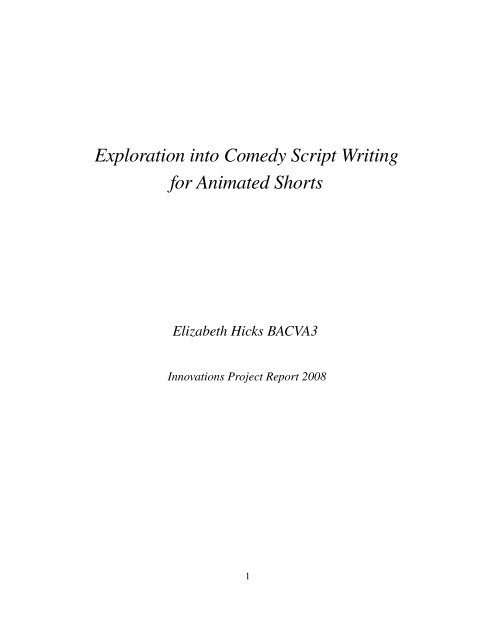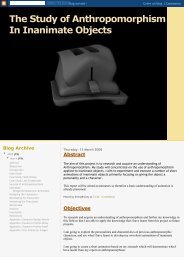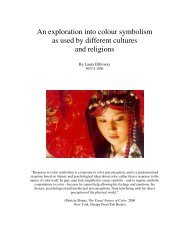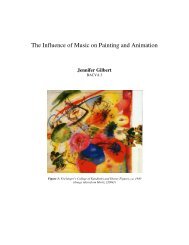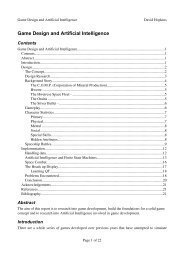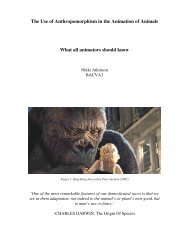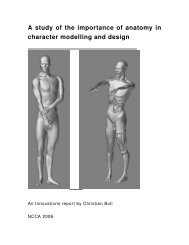Exploration into Comedy Script Writing for Animated Shorts
Exploration into Comedy Script Writing for Animated Shorts
Exploration into Comedy Script Writing for Animated Shorts
You also want an ePaper? Increase the reach of your titles
YUMPU automatically turns print PDFs into web optimized ePapers that Google loves.
<strong>Exploration</strong> <strong>into</strong> <strong>Comedy</strong> <strong>Script</strong> <strong>Writing</strong><strong>for</strong> <strong>Animated</strong> <strong>Shorts</strong>Elizabeth Hicks BACVA3Innovations Project Report 20081
CONTENTS1. Introduction2. Basic Understanding of Storytelling2.1 Plot2.2 Characters2.3 Setting3. <strong>Writing</strong> <strong>for</strong> Animation4. <strong>Writing</strong> <strong>Comedy</strong>4.1 <strong>Script</strong> <strong>Writing</strong> <strong>Comedy</strong>4.2 <strong>Comedy</strong> in Animation4.2.1 Surprises and exploiting expectations4.2.2 Character driven <strong>Comedy</strong>4.2.3 Visual Puns4.2.4 Black Humour and Obscenity4.2.5 Parodies and Spoofs4.2.6 Audience5. My <strong>Script</strong>s6. Conclusion7. References8. AppendixAppendix A: Friends of Fruiton ValleyAppendix B: ConfessionAppendix C: SheepargoAppendix D: Heisyuan (Hez-waan) the TV chef2
AbstractThe aim of this project is to help me understand how to write funny animated shorts. Iwill study how to create a simple short story and the narrative structures used inanimation. I also want to learn how to write comedy, although it is stressed thatcomedy can't be taught, some patterns tend to emerge and it is these patterns that iwill explore and attempt to apply to a few of my own scripts.This report is available to anyone who also wants to broaden their horizons in theworld of comic animation and learn a few tips to help them become script writers.3
1.Introduction'You get to be an impish God... re<strong>for</strong>m the world and take the piss out of it.You turn it upside-down and inside out. ... You change the world and have abrief moment a bit of control over it. At least you get to humiliate it <strong>for</strong> amoment and that's what all cartoonists get their kicks from'As Terry Gilliam states in an interview with Paul Wells (1998, p127), animation is amedium of endless capabilities, however, coming up with a decent narrative, especiallya comic one, needs thought and planning. To be able to sell any idea it is often howprepared you are about it which can make the difference. It is important to explore thedifferent ingredients which help <strong>for</strong>m a narrative and/or script <strong>for</strong> an animated shortand what makes it funny.This essay breaks the process down <strong>into</strong> analysing stories, the capacity <strong>for</strong> animationand essential qualities of comedy. Most of the points made throughout are simplyguidelines, as much as the need <strong>for</strong> comedy is timeless, theories on what people findfunny is completely relative.2.Basic understanding of storytellingTo write any <strong>for</strong>m of narrative, whether it is a novel , screenplay or in this case <strong>for</strong> ananimation, you need to have a basic understanding of storytelling. It there<strong>for</strong>e makessense to begin with an explanation of the modes of storytelling and the ways in whichit is achieved. There seem to be hundreds of books teaching people how to write, and Iam going to try and summarise the essential techniques which are relevant. There arethree basic ingredients which needs to be established when creating a story; plot,characters and setting. Obviously if you are writing a novel then there are a few moreattributes to take on board but I am going to stick to short stories to enable thetransfer of them <strong>into</strong> writing animated shorts.2.1 PlotInspiration <strong>for</strong> the premise of any narrative can come from anywhere; an experienceyou've had, or that others have had; a wondering thought or even the works of otherwriters. However the structure of these ideas can be broken down <strong>into</strong> some simple<strong>for</strong>mulas. A strong piece of advice <strong>for</strong> the beginner about structure is to simply 'Put aman in a tree, throw some stones at him, get him down'. (Stewart, 2006) Whichessentially means that you must establish a scenario or problem <strong>for</strong> your protagonist,add to the difficulty by 'throwing some stones' creating more obstacles to overcome.Finally you must bring him down from the tree, solving the problems that have arisenthroughout.For example, in Pixar's animated short, 'Knick Knack' (1989) We are presented with alittle snowman who is jealous of the other sunny, happy souvenirs whilst he is stuckinside his cold snow globe. He then faces the problem of trying to escape from theglobe to try to get to his the girl by the pool, with each failing attempt he's moredetermined. Until finally he falls from the shelf and escapes from his glass dome, hehas been brought down from the tree! What makes this short so beautifully cruelhowever is that having landed next a new interest, the dome falls back over his head,separating him once more from the outside world.4
Fig 1. Screenshot from 'Knick Knack' (1989)So a story is essentially the retelling of an event or incident, generally involvingsomething or someone changing over time, whether it be a physical change or amental one. For example a journey will have been completed, or an opinion has beenchanged. This basic structure can then be presented in a specific genre and have anindividual plot as well.Christopher Booker believes there are seven basic plots to stories; (Booker, 2004)Overcoming a monster, rags to riches, the quest, voyage and return, comedy, tragedyand rebirth. Personally I think it a little naive and simplistic to classify both comedyand tragedy as types of plots. It would not be sufficient to describe the plot of a film bysaying ‘it’s a comedy’. Furthermore you can have a plot that describes a voyagepresented in a tragic way, or a comedic way and you can also have comedy horrors.Which would complicate the theme even more and so harder to classify the plot as a‘comedy’ or ‘tragedy‘. To my mind, the genre or the theme can be classed as a comedy;but the plot cannot. So if we go by Booker’s theory there are only five basic plots,which isn’t really adequate and doesn’t necessarily cover every plot, but the argumentis digression as essentially are the several basic plots which are at the core of moststories ever written. Whether the audience does it consciously or not, they will have abasic expectation of each of these plots.2.2 CharactersTo be able to create believable characters you need to be able to characterise them,understand who they are and what they're like. Robert McKee suggests 'Truecharacter is revealed in the choices a human being makes under pressure – the greaterthe pressure the deeper the revelation, the truer the choice to the characters essentialnature' (McKee, 1997). So even if you're only writing a short story, knowing yourcharacter well enough means the story can almost write itself. However, whenthinking of characters <strong>for</strong> animated shorts, we need to take <strong>into</strong> consideration how thecharacter looks visually. We not want to waste time showing the character in the moraldilemma revealing the depths of his personality, this would take too long. We generallyneed the audience to 'get' our character from the offset. This means looking at theworld of stereotypes and how people respond to them.5
Stereotyping is quite a sensitive subject but cannot be escaped, especially when mediais involved. Advertising is guilty of using stereotypes as they only have a limitedamount of time to get their message across and so rely on the preconceived ideasviewers have about stereotypes to fast track their point over to the public. However, inthe wonderful world of animation, stereotyping is much more accepted. This could be<strong>for</strong> a few reasons; one of these being that cartoons generally are not meant to beviewed and understood in malicious way, they are generally light humoured. Alsocartoons are often a caricature of real life, an exaggeration of the norm. For example,Apu in 'The Simpsons' (1989) is a stereotypical Indian immigrant, working 24/7 at thelocal shop with an extremely strong Indian accent. Had this been a casting in a liveaction series there possibly would have been a debate about the political correctnessof such a character; however, as it is treated in good humour it is not seen as offensive.Fig 2. Apu from 'The Simpsons' (1989) a fine example of howstereotyping can be light hearted and inoffensive.2.3 SettingSometimes the setting can be the inspiration <strong>for</strong> your entire story, however the storywill obviously not develop until at least one character is introduced. This idea isapplied similarly when it comes to characters and their stereotype. When an audienceis introduced to a setting, there is a certain amount of expectation, whether it be abusy office of tightly packed cubicles or country farm land. Much like when you tell anold joke, if someone says ‘knock knock’ you know what’s coming, and its how the jokerdecides to use this expectation to their advantage that makes the difference betweenwhether it is funny or not.Although these rules aren't applied in all animation it is important to be aware of them.This is because there is a certain amount of expectation that comes with each genre,traditional plot line and stereotype of character. Manipulating these guidelines is agreat way to surprise your audience , a tool which plays a big part in comedy.6
3.<strong>Writing</strong> <strong>for</strong> animationAnimation is a media of endless possibilities. Not only can you produce true to lifeanimations, with straight <strong>for</strong>ward, linear narratives but there are also countless waysto approach the narrative. Animations can be manipulated <strong>into</strong> the symbolic andmetamorphic, by playing with time and space.Metamorphosis means a complete change of image, shape or character. It is a processwhich is rather unique to animation as it means you can create a link between imagesusing a fluid animation rather than simply editing two images together using a fade. Afurther explanation of this can be seen when Paul Wells states ‘ Metamorphosis alsolegitimises the process of connecting apparently unrelated images, <strong>for</strong>ging originalrelationships between lines, objects etc., and disrupting established notions of classicalstory telling’ (1998, p69). This disruption of natural story telling can add poignancy toyour animation, as well being a great tool <strong>for</strong> humour.One example of it being used in this way is in Bill Plympton animations. Bill Plymptonis well known <strong>for</strong> his hand drawn animations, where he often contorts his characters,morphing them <strong>into</strong> impossible and sometimes grotesque situations. Plympton claimsto be heavily influenced by Winsor McKay, ‘He was independent, making his own films.He did all the drawings himself, as do I. He would take realistic situations andexaggerate them <strong>into</strong> the craziest surreal imagery, as do I. … that metamorphosis, thatwild exaggeration of images is something that I really find a lot of humour in.'(Timeout, 2007). A fine example of Plympton’s work is ‘Push comes to shove’(1991).This animation involves two men, stood next to each other, taking it in turns to per<strong>for</strong>mextreme ways of hurting each other but all the while neither of them are getting hurt.With each ‘attack’ we are surprised with how Plympton manipulates the charactersuntil finally it ends with a gentle flick being administered to the nose and the characterbreaking down and crying. After the repetition of the ridiculous with no reaction fromeither party, the fact that the final act is so docile and yet provoking such an extremeresponse makes it the funniest effect.Fig 3. 'When Push Comes to Shove' (1991) Plympton demonstratesmetamorphosis in his animation7
Animation can not only manipulate images in impossible ways, it can also createimpossible scenes and characters. Fabrication is what makes animation so magical, it‘essentially plays out an alternative version of material existence, recalling narrativeout of constructed objects and environments, natural <strong>for</strong>ms and substances, and thetaken <strong>for</strong> granted constitute elements of the everyday world’.(Wells, 1998, p90) It’s amedium which can bring to life inanimate objects, giving them soul and personality.This process of creating anthropomorphic creatures can be a natural way to write anyscript, by simply imagining what the objects and animals around you would say if theycould talk.4. <strong>Writing</strong> <strong>Comedy</strong>Sense of humour is very subjective thing, made harder by to pin down by the fact thatgenuine laughter is a involuntary reaction. Charles Darwin observed that laughterhappens when two contradicting emotions or ideas cause different tensions in yourmuscles. (Cleese and Skynner, 1997) <strong>Writing</strong> comedy can never be specificallyexplained, only explored, and even then there isn't a guarantee everyone will find itfunny. However this spontaneous reaction can often be bought down to three keyelements; timing, exaggeration and surprise.4.1 <strong>Script</strong> <strong>Writing</strong> <strong>Comedy</strong>When it comes to script writing, a good comic dialogue can be quite a task. There is adifference between comedy and comic dialogue, after all comedy can have no dialogueat all. Most comedy which does have dialogue, what is said is often not the only factorin the amusement of the piece. Comic dialogue is comic because of the context of it,being often character driven, or by the setting and timing. After all, even stand-upcomedians come up with a certain persona when delivering their routine, <strong>for</strong> example,the difference between Jack Dee and Peter Kay, Although both are anecdotalcomedians, Jack Dee's dry, pessimistic delivery is integral to the humour. Similarly ifPeter Kay was not so enthused by his nostalgic stories, the audience probably wouldnot be so encouraged to laugh at them.As a comedy script writer you need to be aware of what the character’s saying as wellas how he says it, which is often dependent on the context (again). A simple play onwords is always a classic technique. For example, using the line 'no need to lose yourhead' about a execution by guillotine. It is important not to <strong>for</strong>get that sometimes themost simple jokes are still just as good as more complicated witticisms. Making ascript funnier can be done merely by changing a few of the words to more amusingones, such as replacing the words 'looked at’ with 'ogled'. Some other ways ofbrightening up a script would to be use a bit more alliteration, and having 'c' and 'k'sounds as apparently they're funnier, so a story about a duck is found funnier than if itwas about a goose.A good voice actor is integral to comedy in animation and generally there will be alittle bit of interpretation with any actor. As mentioned earlier good characterisation isimportant, good strong characters generally mean a good strong comedy. Whenwriting a script <strong>for</strong> more than one character, it will generally work much better if thesecharacters are distinctly different from each other. Ronald Wolfe (2003) says how ’inan ideal script…lines should not be interchangeable’. This is more specifically true to8
any series’ of scripts using the same characters as it is often the case where what thecharacter is saying is not necessarily funny, but the recognition of comic characters(either as a type of character, or an individual that the audience knows) is generallyenjoyable. For example, in ’The Simpsons’ (1989) the script does not contain constantjokes, however we find ourselves laughing when Homer once again ignorantlymisinterprets a situation. The audience can subsequently laugh at the characters aswell as with them.In ‘<strong>Writing</strong> <strong>Comedy</strong>’ by Ronald Wolfe (2003), he breaks down some hints <strong>for</strong> verbalgags;Reversals - where you set up a scenario with two or more characters only tohave it flipped on its head at the punch line.Exaggerations - also known as ‘so much’ jokes, <strong>for</strong> example, ‘he eats so much…’taking a situation to its extreme.Comparisons - comparing someone or something to a something ridiculous,strange, or disgusting.Switching - putting a stereotypical character out of there normal environment.Role Reversals - similar to the reversal but instead putting the characters ineach others position, rather than simply reversing the dialogue, swappingcharacters roles!Surprise - simply create a situation, develop it and then knock it down catchingthe audience unaware.Forwards and Backwards in time - this done by using a broad topic of modernculture and either setting it in the past, or showing potentially the consequenceof it in the future in a humorous fashion.Although some of these gags are still a good basis <strong>for</strong> a joke, they do not cover every<strong>for</strong>m of the joke anymore. Particularly when it comes to animation because althoughdialogue can make or break comedy, it must be remembered that animation is a visualmedium. Subsequently it is generally the combination of the visual with itsaccompanying sound complementing each other that make it successful.4.2 <strong>Comedy</strong> in Animation<strong>Comedy</strong> is often said to be at the core of most animated films, after all this is the genrethat all early animated films fell under. In terms of animated shorts there a still manydifferent types of gags. I have included just a few, along with some case studies to backthem up;4.2.1 Surprises and exploiting expectationsThe notion of surprise is intrinsic to writing comedy, looking back to the classic babyjokes such as peek-a-boo and a jack in the box, both have a build up of suspense.Leading the audience (or baby) in expectation, and culminating in a pop! This use ofsurprise is a very popular one in animated shorts that are under a minute as it can takethe <strong>for</strong>m of a quick joke. A simple situation is created with a single comic beat. Acommon set up <strong>for</strong> this is introducing a cute or innocent character and having randomacts of violence happen to it. A prime example of this would be Juliet Stroud’sanimated short ‘Snookles’ (1986) where a very sweet pink baby dragon is asked to singalong with a blue bird, only to accidentally scorch him to cinders. This is also an9
excellent example of using expectation and stereotyping to create humour. The cutesynature of the animation triggers ideas of innocence as does the dragon in the nappy.This lulls the audience <strong>into</strong> false pretences and then the sudden surprise of Snooklesharming the little bird is unexpected. Also, when he then goes on to stuff the charredbird <strong>into</strong> the tree to hide what he has done, it is funny as it is not how we’d expect a‘good’ character to react.Fig 4. Shot from 'Snookles' (1986) an animation whichcreates comedy from harming a very cute character.You can also deliver these surprise pops in a series of punch lines, one after anotherbuilding up generally <strong>into</strong> a final climactic joke. This works whether you choose tohave different jokes, <strong>for</strong> example un<strong>for</strong>tunate events happening to a character, (ChuckJones’ Road Runner (1962)) or whether you choose to repeat the same joke. Repetitionis key in humour, especially when creating any series’. The audience takes greatpleasure in knowing the outcome, and enjoys awaiting the different ways of ithappening. This is done in many cartoons such as Tom and Jerry (1965) and even inmore adult ones such as South Park (1997). Each episode we know Kenny will die, andthe boys will react with the same lines, but both when he dies (the expected) and howhe dies (unexpected) are still entertaining.4.2.2 Character driven comedyAs emphasised earlier, strong characters make a good comedy, and getting theaudience to relate to that character plays a large part as well. ‘Personality’ animationcreates a great range of comic purposes which are all about how the characterper<strong>for</strong>ms to the camera. One way of doing this is through facial expressions, lookingat the camera, any way of getting across the characters motivation and frame of mindis important. This way the audience knows the personality of the victim, so candifferentiate between whether they are laughing apathetically at the innocent victim,or through malice at the deserved victim.‘Cane-Toad: What happened to Baz?’ (2002) which is a rather grim character drivencomedy, manages to create a reaction through several of these techniques. Daz isintroduced to the camera, sat in a dog bowl and breaking wind, His character is builtup <strong>for</strong> the audience as he talks to the camera a little unsympathetically about hismissing friend Baz. Each time he suggests a new scenario we are showed a possibilityof where Baz may be, and just be<strong>for</strong>e he dies, there is a quick glance at the camera. Inthe last clash with the lawnmower as he does it you can see him mouth a swear word.Although there is sympathy <strong>for</strong> Baz, each time we cut back to Daz we are remindedthat it is just one theory and reminded that he is not necessarily hurt. We can also see10
a bit of the relationship between the two toads and their different status’ in the snapshots shown at the beginning. Baz is clearly a very sweet and innocent with his largeeyes and big smile where as compared to Daz who has much more of a sternexpression and though his monologue shows much more common sense and wit abouthim.Status often plays a big part in any comedy. You can reduce a characters statusthrough comic events, or have a battle of wits between two clearly dim-wittedindividuals. Many double acts will work with one character who clearly has a higherstatus than the other. This idea of character topology was explored by Norman Klein,when he looked at each characters role and function and broke it down <strong>into</strong> threeprinciple roles, the controller, the over-reactor and the nuisance. He says ‘thecontroller is usually indestructible in the cartoon, he may feel anguished, but he hardlygets hit…the over-reactor tends to takes the lumps, like the fall-guy in slapstickcomedy…and the nuisance usually starts off the cartoon by annoying the over-reactor,who then keeps the gags flowing’ (Klien, 1993)4.2.3 Visual PunsIn animation, humour is based often on illogical sequences of events. In animation thisis known as 'cartoon logic' (Scott, 2003). This means that although cartoons may takethings to extremes, its never goes to the unfathomable; there is always a certainamount of sense in it all. This logic is especially applicable to the physical slapstick inanimation such as Tom and Jerry (1965). For example if a cartoon character runsthough a barbed wire fence it will get sliced up, much like a piece of dead meat, but ofcourse no real harm will come to the character, which is of course why it is acceptableto laugh at such violence!Another <strong>for</strong>m of visual humour in animation is using metamorphosis as mentionedearlier. This is generally found to be funny as it again is a surprise in the audience eyeswhen one thing or character morphs. This method can be found in endless examples ascartoons are infinitely malleable. Much like the 'Rope Dance' (1986) by RaimundKrumme. In this animation we see two men fight over control over a rope with acontinually shifting rectangular frame. A more popular cartoon using this technique isFelix the Cat and the Magic Bag (1959). He uses his magic bag to morph <strong>into</strong> anythinghe needs like a canoe or a picnic table as well as using his tail to lasso the evilprofessor.4.2.4 Black Humour and ObscenityBlack humour or black comedy is defined as serious subjects being treated in jest, andthe humour is consequently often derived from the irony brought about by thetreatment of the situation. It is often combined with obscene humour which derivesfrom the shock and revulsion felt <strong>for</strong> what is being shown. It is a subject which takes abit of care and sensitivity, and yet also requires the writer to be rather cruel andwicked. Originally simply mixing comedy with extreme violence was considered blackcomedy, One of the most famous children cartoonists, Tex Avery, recognizes therelationship between horror and humour. He thinks that ‘playing on the notion thatsomething may be frightening <strong>for</strong> an individual if it is happening to them, but amusingif the very same thing is happening to somebody else’ (Wells, 1998, p145). True black11
comedy is obviously more popular with the adult market. As this <strong>for</strong>m of humour hasbeen more common over the years, audiences are are harder to shock and blackcomedy is getting more extreme, as far fewer subjects are considered taboo.4.2.5 Parodies and SpoofsUsing existing material and then twisting it and embellishing it somehow is a timeless<strong>for</strong>m of humour. Parodies are so successful because the audience should recognise thesubject the writer is copying and instantly know the way in which it is altered,rewritten or presented. It creates endless comic surprises <strong>for</strong> the audience. The spoofis generally based on mockery of its subject, sometimes ridiculing them or changingthem to the ridiculous. Parody takes several <strong>for</strong>ms; one is musical parody, wheresomeone will rewrite the words of a song. The other is self-parody in which an artist orcharacter satirizes themselves or makes a generalisation of their work. The mostcommon <strong>for</strong>m of the spoof however, is to parody a specific genre, such as a parodyhorror, or documentary ( which now has its own name; mockumentary)One example of a parody animation is Dan Bransfield’s Fishman (2002). The nameitself mocks its origins, which is in fact, Batman (DC Comics). By Simply changing itfrom being about a bat, a sonic hearing, flying, nocturnal mammal with a fair bit ofmystery about it, to being fish man, a far less interesting, absent minded life <strong>for</strong>m, italready sets the tone of the cartoon. The animation begins with two characters,remotely resembling Batman and Robin , mid action sequence on the way to stop arobbery, only to find parking difficult. Fishman has a very straight expression on hisface, whilst his sidekick sits foolishly beside him with a snorkel over his face. Thisanimation not only pokes fun at the arrogance of the superhero, but also at theuselessness of his sidekick.Fig 5. 'Fishman' is an an obvious parody of batman,taking it to extreme ridiculousnessThese different comic devices can be used as a simple short animation or be combinedtogether to compliment each other, <strong>for</strong> example a black comedy parody! Whateverdevices are used one of the most important aspects to think about is what audience isit being targeted.12
4.2.6 AudienceHumour will also vary depending on whether people come from different generations,different cultures and social backgrounds. It is there<strong>for</strong>e important to identify yourdemographic be<strong>for</strong>e you attempt to create a humorous piece of animation though it ispossible to appeal to a wide audience. For example although children tend to like moreobvious slap stick humour and adults prefer a more knowing self conscious approach,several modern animated films have combined the two beautifully, making <strong>for</strong> popularfamily watching. For example in Toy Story 2 (1999) when Buzz is fighting EmperorZerg the animation is very exaggerated and slap stick to entertain the children and yetwhen Zerg reveals he is Buzz’s father, the adults laugh as they recognise the Star Warsreference.5.My <strong>Script</strong>sThis was the first script I tried to tackle was one which was thought up when staying ina Hostel called the Happy Apple when travelling in my year out. My friend and Idisgust how we would much rather stay in a hostel called the Disgruntled Pear, itwould be far more English, what with our natural desire <strong>for</strong> disappointment. This ideadeveloped <strong>into</strong> an animation on how the tomato was constantly being rejected by thefruits. At one point we had decided they may be the from the retired hat of CarmenMiranda. As each character came out they caused both of us to laugh at theridiculousness of such an idea.Transferring it to a script however was a little more complicated than i thought. I usedthe 'comparison' technique when Happy Apple describes Grape as happy as a monkeywith a bicycle as well as using a double-entendre when the homosexual banana claimsto be straight. The language used is quite exaggerated and at times alliterative, all ofwhich contribute to the humour of the animation. However i feel the pace of theconversation did not flow as smoothly as i would have liked. I thought the range ofcharacters worked quite well, especially the dynamic between Happy Apple andDisgruntled Pear. I ended it with slap-stick smack to the head which is a suddenmovement so it ends with a surprise and a smack to the head is always funny.Confession was quite difficult to write finding the line and how far you crossed it, blackcomedy is certainly an acquired taste and i found when discussing how far to take it,there was certainly different levels of tolerance. Clearly <strong>for</strong> an adult audience I tried tomake sure i used the funny words such as duck and cockerel, keeping the wellpronounced accent of the Reverend.'Sheepargo' was just a bit of fun, playing with anthropomorphism and rewriting theclassic hit by Chicago. It not only should appeal to the adult audience with thenostalgia of the song and how it was rewritten, but it should also appeal to a youngaudience with the appealing characters and slap-stick end.Finally 'Hezwaan', a classic comedy full of slap-stick hilarity, a likeable character andunnecessary repartition. With this animation I tried to put much more emphasis on thephysical side, it would be an animation with plenty of squash and stretch andexaggerated mannerisms. I also experimented with the use of repetition, giving thecharacter a slogan of 'Hezwaan made earlier' which is what he says whenever he doessomething wrong.13
6.ConclusionAlthough it is still the case that humour cannot be taught, I now feel i have a muchclearer understanding on the classic theories and ideas behind writing comedy. Itmade me realise how much you need to expose yourself to every <strong>for</strong>m of comedy, andwiden your comic spectrum. Especially as it was some of the lesser known animationswhich inspired me the most. Bill Plympton, more specifically, showed me howsomething so simple and repetitive could cause a great reaction. I feel that if i hadmore time i would have defiantly tried to talk to some writers and try to get some firsthand opinions on their individual approaches to scripts and presenting them tocommercial companies as that is where I would eventually like to take my work. As <strong>for</strong>the my scripts, I would love to develop them further. The Fruiton Valley script I wouldlove to develop it <strong>into</strong> a series of animated shorts and to try and find a suitable visualstyle and try to give the characters a bit more substance. Similarly with 'Hazwaan' Iwould love to be able to develop a good character design. I feel all my scripts were alittle underdeveloped and in parts quite generic. But as most story writers will tell you,whether it is <strong>for</strong> a novel or screen, script writing takes practice, and i feel that i am oncourse to practising my way to a comedy masterpiece!14
7.References:BOOKER, C., 2004, The Seven Basic Plots, ContinuumCLEESE, J. AND SKYNER, R., 1997, Life and How to Survive It, VermillonKLIEN, N., 1993 Seven Minutes: The Life and Death of the American <strong>Animated</strong>Cartoon, VersoMCKEE, R., 1997, Story: Style, Structure, Substance and the Principles ofScreenwriting, ReganBooksSCOTT, J., 2003, How to Write <strong>for</strong> Animation, The Overlook PressSTEWART, J., 2006, Tips <strong>for</strong> <strong>Writing</strong> a Short Story [online], Available fromwww.write101.com/shortstory.htm [Accessed 28 February]TIMEOUT, 2007 Film Bill Plympton [online], Available fromwww.timeout.com/chicago/articles/film/20185/bill-Plympton [Accessed 1 March]WELLS, P., 1998, Understanding Animation, RoutledgeWOLFE, R., 2003, <strong>Writing</strong> <strong>Comedy</strong>, HaleFilms:Cane-Toad: What Happened to Baz?, 2002. Short Film. David CLAYTON andAndrew SILKE. Australia.Felix the Cat: The Magic Bag, 1959. TV. USA: Trans-Lux TVFishman, 2002. Short Film, Dan BRANSFIELD, SIGGRAPH.Knick Knack, 1989. Short Film. John LASSETER. USA: Pixar Animation StudiosPush Comes to Shove, 1991. Short Film, Bill PLYMPTON. USA: Big Man PicturesCorp.Road Runner, 1962. TV. Chuck JONES. USA: Warner Bros. AnimationRope Dance, 1986. Short Film, Raimund KRUMME.Simpsons, The, 1989. TV. Matt GROENING. USA: 20 th Century Fox TelevisionSnookles, 1986. Short Film. Juliet STROUD. USA: Cali<strong>for</strong>nia Institute of the ArtsSouth Park, 1997. TV. Trey PARKER and Matt STONE. USA: <strong>Comedy</strong> Central15
Tom and Jerry, 1965. TV. Joseph BARBERA and William HANNA. USA: MGMTelevisionToy Story 2, 1999. FILM. John LASSETER. USA: Pixar Animation StudiosImages Used In Text:Fig 1:Fig 2:Fig 3:Fig 4:Fig 5:Image [online] Short Film. Knick Knack. 1989. Available fromwww.pixar.com/shorts/kk/index.htmlImage [online] .TV. The Simpsons. Available fromhttp://z.about.com/d/animatedtv/1/0/h/apu.jpgImage [online]. Short Film. Push Comes to Shove. 1991. Availablefrom www.plymptoons.com/biography/img/pushcomestoshove_web.jpgImage [online]. Short Film. Snookles. 1986. Available fromwww.slocartoon.net/cartoons/images/004000/4042.jpgImage [online]. Short Film. Fishman. 2002 Available fromwww.siggraph.org/publications/video-review/sig2002/web/FISHMAN.gif16
8. APENDIXAppendix A:Friends of Fruiton ValleyCharacters:Happy Apple (HA): Irritatingly happy, a generally nuisance but an old childhood friend ofPear.Disgruntled Pear (DP): Life long pessimistic, overall demeanour of disappointment, tendsto take his anger out on anyone.Germanic Grape (GG): Old German grape, a little senile, well past retirement, spends allof his retirement money in the pub.Hypoglycaemic Lemon (HL): Thinks he's a bit of a ladies man however really is a bit of asleaze, tends to constantly hit on the Stawbladies to up his sugar intake.Strawbladies (SL): The females of Fruiton Valley, extremely voluptuous fruity charactersvery little common sense, constant teases of Hypoglycaemic lemon, they tend to hang outin small giggling groups.Banana the Poof (BtP): He is a big gay banana who works behind the bar.Pariah the Tomato (PT): the outcast of the group, tries different ways of convincing theothers that he is in fact a fruit, he's a bit of a nerd and his pedantic nature only annoys theother fruit.Pan <strong>into</strong> pub window, Pub is typical a typical English one, rather quiet roads, sign outside,Everyfruit's favourite watering hole.Inside dressed in hideous patterned wallpaper, the mood is generally subdued, general lowmumbles of the customers apart from the odd giggle from the Stawbladies and the jukebox onrandom. Happy Apple and disgruntled Pear are plating cards.HA: OK, go fishDP: What's the point, we spend every night in this pub and it doesn't get us anywhere, i need a job.HA: Don't be such a misery, Germanic Grape spends all his time here, and he's as happy as amonkey with a bicycle.Camera pans over to Germanic grape in the corner, smoking a frankfurter DP looks confused17
DP:What's that even meant to mean? and besides, he's mental, totally loosing it in his old age...hedoesn't know where he is half the timeHA: Don't be stupid, he's happy to be alive!! he knows the Wurst is yet to come....get it? thewurst.... cuz he German!Disgruntled Pear, is yet to react...looks around the room <strong>for</strong> anyone else to talk toHA: Ah come on, you love me really? why else would you sit with me?DP: Well lets have a look around shall we, we have the mental <strong>for</strong>eign grape, a great big yellowpoofter, and a hypoglycaemic lemon who wont leave the biggest bimbo's of the berries alone!HA: Awww, I'm touched, come on its your go!!as they get back to playing cards the door swings open and Pariah Tomato enters, the pub fallssilentDP(angrily): What are you doing here?PT:I'm allowed... Where does it say I'm not allowed?HL: this is a fruit only pub, vegboy, clear off.PT: how many times do i have to tell you? I am a fruit! Botanically I have seeds!! that means I'm afruit dammit!BtP: honey you're about as fruity as I am straight!HA (nudging DP) : see what he did there straight?! banana?DP: Look, what the barman says goes alright? just get out, you tasteless savoury geek.The bar all join in in taunting Pariah Tomato until he eventually leaves. The bar falls silent.HA: How about this one... Why couldn't the orange get up the hill?Disgruntled Pear just smacks him round the back of the head and he lands face down on the table.18
Appendix B: an attempt at a black comedyConfessionRev. Paul Yates, sits in the confession box, being interviewed by the camera. He is a gaunt man,seems like even his coffee cup is too heavy to hold as it shakes slightly in his grasp. He has a quiteaged raspy voice, slightly effeminate but well spoken.Some days I can spend hours in here…just listening… I like tojust sit and listen, just letting them talk, its a little game i like toplay, I mean I know they're here <strong>for</strong> <strong>for</strong>giveness from me…but ifyou just sit here, you can almost hear the guilt eat away at them,human behaviour, its fascinating when under pressure like that,left in a little wooden box of relief, with nothing but a little wickerhole to talk to. This one gentleman, Harold Pimms, part of theflock <strong>for</strong> years, nice man, 5 kids, does the Easter egg hunt, hecame in here, wanting <strong>for</strong>giveness <strong>for</strong> watching one of those bluemovies... i stayed silent... he continued to describe the content,terrible stuff, ... interspecies relations... ducks and cockerels,donkeys and cucumbers... farm themed i believe, all soundedextremely strange ... he went on to say how he went to the localfarmers market and bought a young Shetland and a turkey, said hewanted to create a small flying pony, i mean the insanity of it all!He told me how he strapped them together with duct tape, and juststarted yelling at them! he got so worked up telling me about it, Icould feel him shaking on the other side of the bench, his wifewalked in on him, <strong>for</strong>cing the turkey <strong>into</strong> the pony's anus... not asomething you can excuse yourself from, he broke down that day,right here in this church ... haven't seen him in a while...poorbastard.19
Appendix C: ParodyIf you sheer me now (Sheepargo)At a sheering station, just as a farmer picks up a very fluffy young Ram, a spotlight appears and hebegins to sing... accompanied by three back up sheep.(to the tune of 'if you leave me now' by Chicago)If you sheer me now, you take away the warmest part of me!if oooooonly my wool didn't grow.'cuz with out my coat, i don't think i could function properly,ooooh what would ladies think of me?The ewes agree a ram like me's divineWhy would you take such love awayWith out that love you'd leave them all in wantingleaving the lambs with out their daddy!When your farm breaks down from lack of babesyou know you'll think back and sayIts 'cuz I stripped him down, and now my farm is going down the panOOO oh what a fool I've been!So if you think of what....Mid song, the farmer grabs the sheep off screen, wool flies everywhere, and he is returned to thescreen in the buff20
Appendix D: SlapstickHeisyuan (Hezwaan) the TV chefset is very typical tv kitchen layout, we see Heisyuan, our portugeise chef, smiling at the cameraHeisyuan:Hullo, Good evening everybody and welcome to Heisyuan's Happy Hamper, where we have funmaking lots of lovely food together!!! Today we are making fairy cakes!! First we need some nicefresh butterHeisyuan reaches <strong>into</strong> a small fridge, pulls out a out a huge cow, MooingHeisyuan:Oop too fresh!reaches back <strong>into</strong> the fridge and pulls out a chickenHeisyuan:Ooh lordy, what else is in here?Heisyuan puts the chicken on the side and pulls out some butter.Heisyuan:Okeydokey, make sure your butter is nice and soft, so you can mix it with your sugar.Heisyuan pokes the butter, its rock hard... he pops it in his hands and blows on it and gives itanother poke, still hard, he slams it on the work surface twice, the third time he misses it and itfalls to the floor, he jumps on it in frustration and slips to the floor. He remurges from behind thecounterHeisyuan:ooh lordy, i broke the butter. not to worry, Heisyuan made earlier!He produces a bowl with butter some soft looking butter in itHeisyuan:21
Now, we mix in the sugar until nice and fluffy!He pops the bowl under an electric whisk and starts it, the whisk starts to move too fast and beginsto knock the bowl in circles. the mixture beings to fly around. Heisyuan begins to panic and tries toturn it off. the bowl flings out of control, off the whisk and he has to duck as it smashes against thewall behind his head.Heisyuan:Not to worry! Heisyuan made earlier!!!He emerges once more with a fresh bowlHeisyuan:Alrighty, now we need some beaten eggs (turns to the the chicken) i do apologise Mrs chickenHeisyuan rolls up his sleeves and punches the chicken in the face and an egg pops out the otherendHeisyuan:Beautiful egg Mrs chicken! I thank you!He cracks the egg <strong>into</strong> the bowl and and mixes it together.Heisyuan:Lovely creamy mixture you see! Ok time to find some flour!He takes off a lid of a tin labelled 'Flour' and some daisies pop out of the lid, he looks confused,goes to the window, pulls out a plant pot and has a look in itHeisyuan:ah ha!As he breaths in he sneezes and drops the flower pot, a big cloud of flower spreads over thealready messy kitchen. Heisyuan has a sneezing fit22
Heisyuan:oh lordy, not to worry! Heisyuan made earlier!Heisyuan stirs the flour <strong>into</strong> the mixture and begins to set out the cupcake holders.Heisyuan:We now, scoop all the goo <strong>into</strong> the holdersHeisyuan scoops out a portion of mixture over the tray, and it doesn't drip of, he starts to flick hiswrist in agitation, and get it still doesn't come off the spoon. he then flicks his wrist so rapidly themixture flies off the spoon and up in to the air, he looks up and it doesn't come down.Heisyuan:eh? huh, not to worry!!he produces another tray of raw cupcakes.Heisyuan:now to the oven! be careful it can get very hot!Heisyuan opens the oven only <strong>for</strong> a huge flame to engulf the kitchen and smoke blasts in front ofthe camera. When the smoke dies down the kitchen as charred, as is Heisyuan, he coughs andclears his throat, holds three signs, reading, 'not ''to' 'worry' and he jumps up and grabs thecorner of the screen, pulls it back to reveal a new kitchen with fresh cupcakes on the counter. hesmiles picks one up to take a bite, as he does this, the mixture from earlier drops down onto hishead.23


